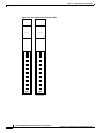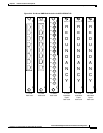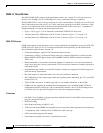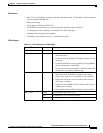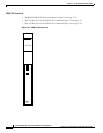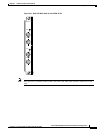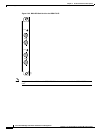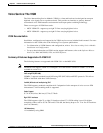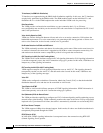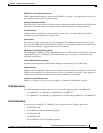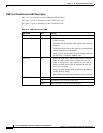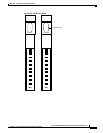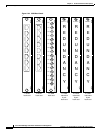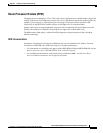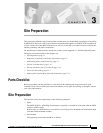
2-56
Cisco MGX 8230 Edge Concentrator Installation and Configuration
Release 1.1.31, Part Number 78-11215-03 Rev. B0, May 2001
Chapter2 Module and Service Descriptions
Frame Relay Service Modules
T3 Interfaces (via SRM Bulk Distribution)
T3 interfaces are supported using the SRM’s bulk distribution capability. In this case, the T3 interfaces
are physically terminated at the SRM module. The SRM module breaks out the individual T1s and
distributes the T1s via the TDM backplane bus to the individual VISM cards for processing.
Echo Cancellation
The VISM provides on-board echo cancellation on a per-connection basis. Up to 128 msec
user-configurable near-end delay can be canceled. The echo cancellation is compliant with ITU G.165
and G.168 specifications.
Voice Activity Detection (VAD)
VISM uses VAD to distinguish between silence and voice on an active connection. VAD reduces the
bandwidth requirements of a voice connection by not generating traffic during periods of silence in an
active voice connection. At the far-end, comfort noise is generated.
Fax/Modem Detection for ECAN and VAD Control
The VISM continually monitors and detects fax and modem carrier tones. When carrier tone from a fax
or modem is detected, the connection is upgraded to full PCM to ensure transparent connectivity. Fax
and modem tone detection ensures compatibility with all voice-grade data connections.
CAS Tunneling via AAL2 (For AAL2 Trunking Mode)
The VISM in AAL2 mode facilitates transport of CAS signaling information. CAS signaling information
is carried transparently across the AAL2 connection using type 3 packets. In this mode, VISM does not
interpret any of the signaling information.
PRI Tunneling via AAL5 (For AAL2 Trunking Mode)
VISM supports transport of D-ch signaling information over an AAL5 VC. The signaling channel is
transparently carried over the AAL5 VC and delivered to the far-end. In this mode, VISM does not
interpret any of the signaling messages.
Voice CAC
VISM can be configured to administer Connection Admission Control (CAC) so that the bandwidth
distribution between voice and data can be controlled in AAL2 mode.
Type 3 Packet for DTMF
The VISM in AAL2 mode facilitates transport of DTMF signaling information. DTMF information is
carried transparently across the AAL2 connection using type 3 packets.
Dual (Redundant) PVCs for Bearer/Control
The VISM provides the capability to configure two PVCs for bearer/signaling traffic terminating on two
external routers (dual-homing). VISM continually monitors the status of the active PVC by using OAM
loopback cells. Upon detection of failure, the traffic is automatically switched over to the backup PVC.
64 K Clear Channel Transport
The VISM supports 64 Kbps clear channel support. In this mode, all codecs are disabled and the data is
transparently transported through the VISM.
DTMF Relay for G.729
In VoIP mode, DTMF signaling information is transported across the connection using RTP NSE
(Named Signaling Event) packets



